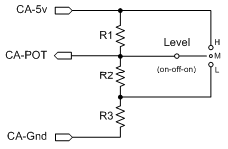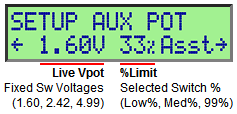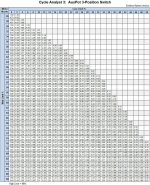Configurable AuxPot 3-Position Switch Using Fixed Resistors
This describes how to construct an AuxPot 3-position switch to limit any of: Current, Power, Speed, or PAS Assist. The switch selects one of three percentages of the configured limiting parameter: (high, med, low) = (100%, Lmed, Llow) e.g. (100%, 66%, 33%). Although fixed resistors are used, a wide range of Lmed and Llow values can be configured using Setup.
Theory of Operation
The idea is to establish fixed switch-selectable voltages but shift the endpoints of the allowable AuxPot input voltage range to alter the way those voltages appear relative to one another and to the overall AuxPot range.
The switch is wired as shown below. For accessory current inventory purposes, this circuit draws a maximum of 0.53ma. The switch can be any center-off SPDT toggle or rocker switch - or any of the commercially available ebike 3-position switches. Current is very low - resistor wattage can be anything available (1/8W, etc).
This can be fabricated many ways, including squeezing the resistors into the side cover of common 3-speed ebike switch. However, an easy technique that is pretty stealthy is to cut the cable of an ebike 3-speed switch and splice the resistors in-line. Choose some part of the cable run that is relatively straight and will not be subject to flex. Leave the end resistor leads a little long and spiral wrap the whole thing with waxed dental floss (DIY cable lacing twine) out to the end of the resistor leads so they are bound to the insulated cable wire for strength. Sleeve with a couple of layers of heatshrink.
Before you add the outer heatshrink, verify the pin-to-pin resitances below with a meter for the three switch positions. Then plug the cable into the CA, navigate to the Setup AuxPot Section Preview screen and check that the voltages are as shown in the table for the three switch settings. If all is well, apply the outer heatshrink.
This printable PDF has the images above for bench use.
Configuration
This is a printable PDF of the settings table for shop use/road adjustments.
For example, to set up the switch for PAS Assist at levels (750W, 450W, 250W):
There is a new Grin Tech 3-position switch that prompted this post - it uses the identical fixed resistance/adjustable min/max strategy, but with a slightly different four resistor circuit. The fixed voltages are: (L,M,H) = (1.66v,2.50v,3.33v). The 3-resistor circuit presented in this post appears to provide a bit wider adjustment range (I have an email out to Justin about this).
This is a printable PDF of the settings table for shop use/road adjustments for the Grin Tech 3-position switch.
Operation as a Preset Switch
This ES switch can be used as a 3-position Preset Switch by setting (AuxMinIn, AuxMaxIn) to (2v, 3v).
The Grin Tech switch can be used as a 3-position Preset Switch by setting (AuxMinIn, AuxMaxIn) to (1v, 4v).
EDIT - This information is now part of the Guide.
This describes how to construct an AuxPot 3-position switch to limit any of: Current, Power, Speed, or PAS Assist. The switch selects one of three percentages of the configured limiting parameter: (high, med, low) = (100%, Lmed, Llow) e.g. (100%, 66%, 33%). Although fixed resistors are used, a wide range of Lmed and Llow values can be configured using Setup.
Theory of Operation
The idea is to establish fixed switch-selectable voltages but shift the endpoints of the allowable AuxPot input voltage range to alter the way those voltages appear relative to one another and to the overall AuxPot range.
- In the illustration below, the red portion shows the maximum AuxPot voltage range and several voltages determined by fixed resistors.
- The green scales show three different possible working ranges of AuxPot input as determined by (AuxMinIn,AuxMaxIn). Although limits Llow and Lmed are bound to fixed voltages, the overall green scale can be shifted left or right or expanded or compressed by moving the endpoints - this changes the relative position of Llow and Lmed in that range and thus their effective values. So - it's all a matter of point of view....
- The relative values of the fixed voltages also impose certain limitions on the possible Limit Value configurations. The trick is to pick voltages that will allow a range of commonly useful limit settings.
The switch is wired as shown below. For accessory current inventory purposes, this circuit draws a maximum of 0.53ma. The switch can be any center-off SPDT toggle or rocker switch - or any of the commercially available ebike 3-position switches. Current is very low - resistor wattage can be anything available (1/8W, etc).
This can be fabricated many ways, including squeezing the resistors into the side cover of common 3-speed ebike switch. However, an easy technique that is pretty stealthy is to cut the cable of an ebike 3-speed switch and splice the resistors in-line. Choose some part of the cable run that is relatively straight and will not be subject to flex. Leave the end resistor leads a little long and spiral wrap the whole thing with waxed dental floss (DIY cable lacing twine) out to the end of the resistor leads so they are bound to the insulated cable wire for strength. Sleeve with a couple of layers of heatshrink.
Before you add the outer heatshrink, verify the pin-to-pin resitances below with a meter for the three switch positions. Then plug the cable into the CA, navigate to the Setup AuxPot Section Preview screen and check that the voltages are as shown in the table for the three switch settings. If all is well, apply the outer heatshrink.
This printable PDF has the images above for bench use.
Configuration
- Set appropriate Setup parameter (e.g. PLim->MaxCurrent, PLim->MaxPower, Pas->PasWatts) to desired maximum value.
- Determine LowLimit% = ( LowValue/MaximumValue)*100.
- Determine MediumLimit% = (MediumValue/MaximumValue)*100.
- Locate proper cell in table at (col,row) = (LowLimit%, MediumLimit%)
- Transfer cell values to Aux->AuxMinIn and Aux->AuxMaxIn.
- Go to Setup AuxPot Section Preview screen, verify switch settings (L,M,H) display limits of (LowLimit%, MediumLimit%, 99%).
- If limits are not exactly as desired, then locate the appropriate adjacent cell and modify both AuxMinIn and AuxMaxIn toward those new cell values.
This is a printable PDF of the settings table for shop use/road adjustments.
For example, to set up the switch for PAS Assist at levels (750W, 450W, 250W):
- Set PAS->PASWatts = 750W
- LowLimit% = 250W/750W x 100 = 33%
- MedLimit% = 450W/750W x 100 = 60%
- Look up row 60%, column 33% in table. Use nearest cell (60,32) and get (0.65, 3.57)
- Go to Setup PAS section
- Set AuxMinIn = 0.65, AuxMaxIn = 3.57
- Go to PAS section preview screen and operate switch - Asst% should show (99%,60%,32%)
There is a new Grin Tech 3-position switch that prompted this post - it uses the identical fixed resistance/adjustable min/max strategy, but with a slightly different four resistor circuit. The fixed voltages are: (L,M,H) = (1.66v,2.50v,3.33v). The 3-resistor circuit presented in this post appears to provide a bit wider adjustment range (I have an email out to Justin about this).
This is a printable PDF of the settings table for shop use/road adjustments for the Grin Tech 3-position switch.
Operation as a Preset Switch
This ES switch can be used as a 3-position Preset Switch by setting (AuxMinIn, AuxMaxIn) to (2v, 3v).
The Grin Tech switch can be used as a 3-position Preset Switch by setting (AuxMinIn, AuxMaxIn) to (1v, 4v).
EDIT - This information is now part of the Guide.






